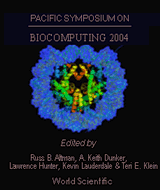The effects of alternative splicing on transmembrane proteins in the mouse genome
Cline MS, Shigeta R, Wheeler RL, Siani-Rose MA, Kulp D, Loraine AE
Affymetrix Inc., 6550 Vallejo Street, Suite 100, Emeryville, CA 94608, USA.
Pac Symp Biocomput. 2004;:17-28.

Abstract
Alternative splicing is a major source of variety in mammalian mRNAs, yet many questions remain on its downstream effects on protein function. To this end, we assessed the impact of gene structure and splice variation on signal peptide and transmembrane regions in proteins. Transmembrane proteins perform several key functions in cell signaling and transport, with their function tied closely to their transmembrane architecture. Signal peptides and transmembrane regions both provide key information on protein localization. Thus, any modification to such regions will likely alter protein destination and function. We applied TMHMM and SignalP to a nonredundant set of proteins, and assessed the effects of gene structure and alternative splicing on predicted transmembrane and signal peptide regions. These regions were altered by alternative splicing in roughly half of the cases studied. Transmembrane regions are divided by introns slightly less often than expected given gene structure and transmembrane region size. However, the transmembrane regions in single-pass transmembranes are divided substantially less often than expected. This suggests that intron placement might be subject to some evolutionary pressure to preserve function in these signaling proteins. The data described in this paper is available online at http://www.affymetrix.com/community/publications/affymetrix/tmsplice/.
[Full-Text PDF] [PSB Home Page]